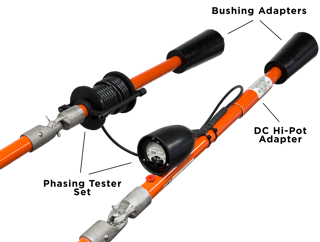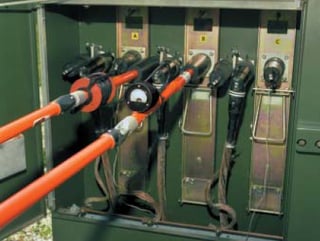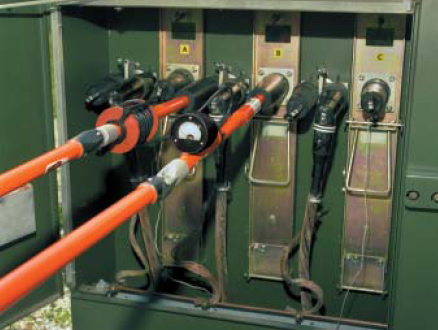The CHANCE® DC hi-pot adapter has proven to be a very valuable tool for locating faulted cables in an underground loop. It is a simple, reliable tool that adds capability to the lineman’s existing CHANCE 5/16kV or 16kV phasing sets, allowing immediate cable testing during storms and new construction. The compact size and low cost, compared to other available diagnostic cable testers, allows for multiple trucks to do cable testing without long outages while waiting for more expensive and complicated equipment to arrive on the job site.
Utilizing the DC hi-pot adapter also limits exposure of the suspect cable run to additional damage from high fault currents. The DC hi-pot adapter is a compact adapter that fits on the end of the phasing set by use of the ¼” x 20 stud, just like an extension resistor would. Provisions include being able to safely interface to the cable through use of bushing adapters and feedthroughs.
The old method of locating a fault was to repeatedly re-fuse at the riser pole and close the fuse in on different sections of cable. By dividing a URD loop in half and closing the fuse, one could tell whether that cable section was good or bad. If the fuse blew, one divided the bad section of the cable in half, re-fused and closed in. This was continued until the faulted section of cable was determined. Each time a fuse blows on a riser pole, damaging high fault current stresses the cable, elbows, bushing wells, transformers and any feedthrough junctions between the fuse and the fault. Especially at night, the loud report of the fuse operating can disturb nearby people. In addition, during these “fire-in-the-sky” fuse tests of cable sections, customers’ lights go on and off and may expose their equipment to damaging power surges.
Utilities have discovered that using the DC hi-pot adapter on phasing sticks, allows a safe, silent and non-damaging way to test the isolated cable condition before energizing. The adapter is basically a diode that converts the AC line voltage to a DC voltage, which is equivalent to the peak AC value. One analogy to describe the DC hi-pot adapter test method is to compare it to a DC battery charger. In the battery scenario, when a good battery is charged, the initial meter indication goes high and then “falls off” as the battery comes to a charged state. This is the same meter indication you will see with a good section of cable that is isolated, discharged and then tested with the phasing sticks/DC hi-pot adapter combination.
A good section of cable under test will show an initial high meter reading. Then, as the cable becomes charged and holds the voltage charge after a few seconds, the phasing set meter reading will “fall off” to near zero indicating the cable is charged to the DC equivalent of the AC source voltage. If the isolated cable section under test is bad, the phasing set meter reading goes high and stays high throughout the entire test. This indicates a bad cable section which does not become fully charged. The bad cable section has a leakage path to the concentric neutral, draining off any DC charge on that cable section.
The DC hi-pot adapter converts the AC line voltage to a DC voltage equivalent to the peak AC value. For example, with a 7200-volt AC single-phase URD line, approximately 10 kV DC is applied during the test to the isolated cable. The DC hi-pot adapter also functions as a half-wave rectifier, so if measuring the phase-to-ground voltage on the AC source, the phasing set will read half the RMS voltage. This allows the 16kV phasing set with DC hi-pot adapter to be used on a 35kV system. 
When using this system, the utility always disconnects, isolates both ends of a cable and then safely discharges the cable section prior to and after each test. See the instructions for further details. Once the DC hi-pot adapter is properly installed on the phasing set, the DC voltage should be safely applied to the isolated and discharged cable. As a reminder, a good cable will hold a charge so the voltmeter on the phase stick will show a voltage for a second or so until the cable becomes charged. Then the voltage difference will drop to near zero volts. However, when the utility energizes a bad section of cable, the fault drains off the charge and the meter continuously reads a high potential.
Just as easily, the adapter quickly tests new or repaired cables, too. It checks that the repair was the only fault on the cable and confirms that the repairs were effective. Frequent pumping of high-fault (potentially damaging) current through the good cables and other equipment, terminations and splices is avoided.
To verify proper operation of the DC Hi-Pot adapter, connect one side of the phasing set / DC Hi-Pot adapter to the neutral (ground) and safely insert the other stick of the phasing set into a known high voltage A.C. source. If you see a reading that appears to be approximately one third of the phase-to-phase voltage or approximately half of the phase-to-ground voltage, the DC Hi-Pot adapter is working as designed.
Safety is always the priority when using these tools. In addition to the provided operating instructions for each device, follow all applicable government and utility standard work practices, procedures and best practices for tool use.







